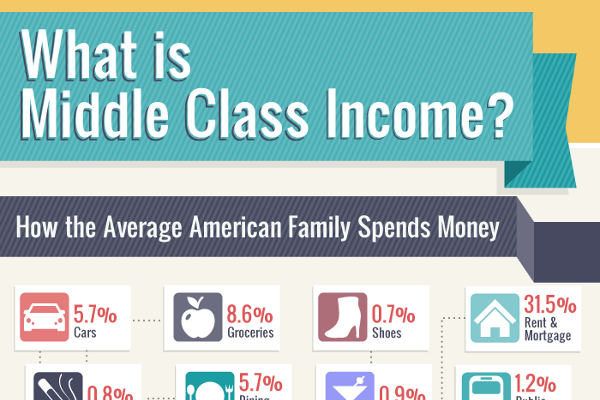Defining Middle Class Income Across The United States

Table of Contents
The Elusive Definition of Middle Class Income
Defining middle class income in the United States is surprisingly difficult. There's no single, official definition accepted nationwide. Different researchers and government agencies employ various approaches, leading to varying interpretations and conclusions.
This lack of a standardized definition stems from the multifaceted nature of socioeconomic status. While household income is a key factor, it doesn't paint the whole picture.
-
Median household income as a common benchmark: Often, the median household income is used as a starting point. This represents the middle value in a dataset of all household incomes, meaning half earn more, and half earn less. However, this alone is insufficient for a complete understanding.
-
Limitations of using median income alone: Median income doesn't account for crucial factors like wealth (assets minus liabilities), accumulated savings, or the significant variations in cost of living across different geographical locations. A family with a median income in a rural area may enjoy a higher standard of living than a family with the same income in a major metropolitan area.
-
Percentile-based definitions: Another approach uses percentile rankings. For example, the middle 60% of the income distribution might be considered the middle class. This method offers a broader perspective but still doesn't account for the cost of living discrepancies.
Regional Variations in Cost of Living and Middle Class Income
The cost of living significantly impacts the definition of middle class income. What constitutes a middle-class income in one region may be considered low-income in another. This is largely driven by differences in housing costs, transportation expenses, healthcare access, and the overall price of goods and services.
-
Examples of high cost-of-living areas: Major metropolitan areas like New York City, San Francisco, Boston, and Los Angeles consistently rank high in cost-of-living indices. In these areas, a significantly higher income is required to maintain a similar standard of living compared to lower cost-of-living areas.
-
Impact of housing costs on middle-class affordability: Housing is a major driver of cost-of-living variations. In expensive housing markets, a substantial portion of a household's income is dedicated to rent or mortgage payments, leaving less for other essential expenses.
-
Examples of lower cost-of-living areas: Many parts of the Midwest and South offer a lower cost of living, meaning a household can maintain a comfortable middle-class lifestyle on a comparatively lower income.
[Insert a map or chart here visually representing regional differences in median income and cost of living. Data sources should be cited.]
Factors Beyond Income: Defining Socioeconomic Status
A comprehensive understanding of middle class status requires looking beyond income alone. Socioeconomic status (SES) encompasses a broader range of factors:
-
The role of homeownership in defining middle class status: Homeownership has traditionally been a significant marker of middle-class attainment. Owning a home represents a substantial asset and provides a sense of financial security.
-
The impact of education levels on earning potential and socioeconomic standing: Higher levels of education are strongly correlated with higher earning potential and improved socioeconomic standing. A college degree or advanced professional training often opens doors to higher-paying jobs and greater career stability.
-
Occupation types associated with the middle class: Certain occupations are traditionally associated with the middle class, including teachers, nurses, skilled tradespeople, and managers in various industries. However, the income associated with these professions varies significantly across locations and job markets.
The Changing Landscape of the Middle Class in the United States
The size and financial stability of the middle class in the United States are constantly evolving, influenced by various factors:
-
Stagnation of wages relative to cost of living increases: In recent decades, wage growth for many middle-class workers has not kept pace with inflation and increases in the cost of living. This has led to a squeeze on household budgets and increased financial insecurity for many families.
-
The rise of the gig economy and its impact on middle-class income security: The growth of the gig economy has created new opportunities but also introduced challenges. Gig workers often lack the benefits and income stability enjoyed by traditional employees, impacting their financial security and long-term prospects.
-
Policy implications for supporting and expanding the middle class: Government policies play a crucial role in shaping the economic landscape and impacting the middle class. These policies, ranging from minimum wage laws to tax policies and social safety nets, significantly influence the financial well-being of middle-class families.
Conclusion
Defining middle class income in the United States presents significant challenges. There's no simple answer, as the definition is inherently fluid, influenced by regional variations in the cost of living and factors beyond income, such as wealth, education, and occupation. Understanding middle class income requires a holistic perspective that accounts for these complex interactions. The ongoing stagnation of wages relative to rising costs of living, coupled with the changing nature of work, further complicates the picture.
To gain a deeper understanding of middle class income and its implications for policy and social well-being, explore resources that provide detailed data on household income and cost of living across the country. Continue the conversation – understanding middle class income is vital to addressing the economic challenges facing our nation and promoting middle-class financial stability. Further research into defining middle class in the US is critical for informed policy decisions and equitable societal progress.

Featured Posts
-
 Nezvichna Posadka Trampa Ta Zelenskogo Poyasnennya Ta Interpretatsiyi
Apr 30, 2025
Nezvichna Posadka Trampa Ta Zelenskogo Poyasnennya Ta Interpretatsiyi
Apr 30, 2025 -
 Aprovecha 3 Dias Para Inscribirte A Clases De Boxeo En Edomex
Apr 30, 2025
Aprovecha 3 Dias Para Inscribirte A Clases De Boxeo En Edomex
Apr 30, 2025 -
 Un Reboot De X Files Par Ryan Coogler Analyse Et Perspectives
Apr 30, 2025
Un Reboot De X Files Par Ryan Coogler Analyse Et Perspectives
Apr 30, 2025 -
 A Comprehensive Timeline Of Channing Tatum And Inka Williams Romance
Apr 30, 2025
A Comprehensive Timeline Of Channing Tatum And Inka Williams Romance
Apr 30, 2025 -
 Coronation Street Actor Reveals Heartbreaking Details Of Final Day
Apr 30, 2025
Coronation Street Actor Reveals Heartbreaking Details Of Final Day
Apr 30, 2025
